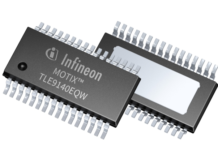
A supply shortage in semiconductors for the automotive market is expected to cause temporary disruption, but suppliers expect to absorb the demand based on the light vehicle production forecast for 2021.
With demand falling for most part of 2020 due to the COVID-19 pandemic, automakers and tier-1 suppliers have reduced their inventory. Automotive semiconductor vendors have canceled orders to external foundries, while internal capacity was halted or slowed either intentionally or as a result of reduced labor availability due to the pandemic.
However, with industries opening up in the last couple of months and automotive demand increasing, there are signs of disruption in the supply chain. Last week, key suppliers and OEMs suggested the shortage of semiconductors could affect vehicle production in the world’s biggest vehicle market, mainland China. This was confirmed by the China Association of Automobile Manufacturers (CAAM), which has suggested a “relatively big impact” in some automotive production at first three months of 2021 owing to the shortage. Top chipmakers have also acknowledged this shortage, and price increases may result. These chips are primarily used in Electronic Stability Program (ESP) and engine control units (ECUs). Additionally, there have been reports of supply issues for imported microcontrollers, leading to reduced ability to deliver to the automotive market demand in India.
Multimarket demand weighs on semiconductor supply
The auto industry’s recovery in the third and fourth quarters of 2020 has begun to put some signs of stress on the supply chain. In one example, IHS Markit estimates that the demand for semiconductors across other industries in the final quarter of 2020 increased at a stronger-than-expected rate. The increase in production of new smartphones leveraging 5G capabilities and the recent introduction of new gaming platforms, including Sony’s PlayStation 5 and Microsoft’s Xbox Series X, resulted in these segments consuming the front-end capacity available due to earlier cancelations by automotive manufacturers while demand was low and the prospects for recovery were unknown. Adding to it, with Christmas and Chinese New Year coming up, spare capacity is in short supply, especially at the external foundries.
The growth of xEVs (x = mild, fully hybrid electric vehicles) is driving the increasing need for semiconductors in the automobile industry, given that xEV systems require considerably more semiconductor content than conventional propulsion systems. These hybrid and fully electric vehicles (EVs) often are equipped with more advanced driver assistance systems (ADAS) and infotainment features. These advanced entertainment systems, digital clusters, heads-up displays (HUDs), safety features, and ADAS technologies require systems-on-chip (SoCs) designs that need highly advanced process nodes and that are likely to put added pressure on the already-constrained foundries.
A return to normalcy?
“The current challenges are not structural problems that require capital expenditure increases to fix, these are a result of a perfect storm of non-automotive segments consuming wafer fab capacity with new products before the holidays, said Phil Amsrud, a senior principal analyst with IHS Markit. With Intel’s historic order with Taiwan Semiconductor Manufacturing Company (TSMC) before the automotive recovery began taking shape, coupled that with automotive customers having to share the highest priorities with other segments, it appears that the first half of 2021 will be a difficult period for the industry.”
In an opportunity to overcome the supply issues, some suppliers are reconsidering their internal wafer capabilities and priorities and looking at options to bring some of the production back in house because of the foundries’ constraints. Raising prices is also an option for some suppliers, but the circumstances are a bit complicated with 2021 contracts just starting. The suppliers are also looking to lock down longer commitments from customers, which would provide long-term visibility for capacity planning and minimize risk of suppliers being stuck building risk inventory.
“The challenges will remain until lead times begin to decrease to less than 26 weeks and become in line with the usual 12–16 weeks for MCUs [microcontrollers] and SoCs,” said Amsrud. He added, “The effect of this increase in lead time will affect MCUs and SoCs compared with other product types because MCUs have proprietary architectures and are therefore difficult to move from one supplier to another. On the other hand, memories, standard logic, discretes, and power devices usually have multiple qualified suppliers.”
Currently, there are no signs of an upcoming long-term allocation crisis, however the real risk for an allocation crisis to develop like in that 2010 is if tier-1 suppliers and automakers begin panicking when faced with an extended lead times and order more than what is required. Inflated orders would result in suppliers misinterpreting the actual demand, which could lead to a significant imbalance between demand and supply. It could lead to more shortages in the first half of fiscal 2021, especially for multipurpose chips such as microcontrollers, resulting in the need for an inventory correction to absorb all the excess chip production in the second half of 2021.
Semiconductor suppliers should be able to absorb the demand based on the light vehicle production forecast over the course of 2021. Despite lead time significantly increasing, there are likely to be only few anecdotal episodes of shortages on high-demand vehicles such as pickup trucks in the US and not industry-wide disruptions.
IHS Markit Commentary and Analysis By: Phil Amsrud, Dexin Chen, Arnab Paul
December 23, 2020



















